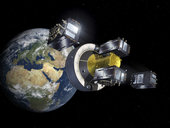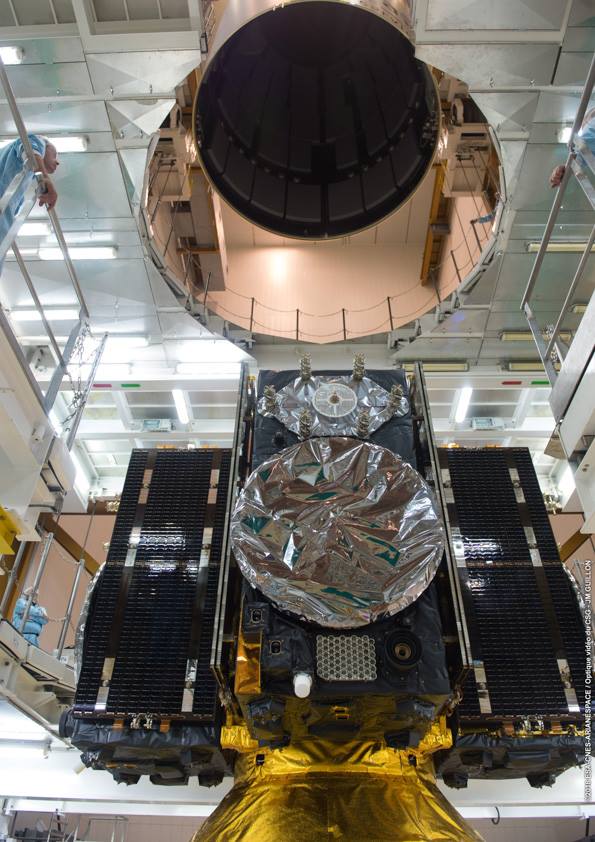
An Ariane 5 launcher uniquely modified to loft four of Europe’s Galileo navigation satellites on one flight has received its payload for liftoff next week in French Guiana.
The satellite quartet will boost the size of the Galileo fleet to 18 spacecraft. Officials say 24 satellites are needed for the European navigation network to provide global positioning and timing services independent of U.S. or Russian navigation fleets.
Liftoff is set for Nov. 17 at 1306:48 GMT (8:06:48 a.m. EST), or 10:06 a.m. local time at the European-run space base in Kourou, French Guiana.
The launch is a rare morning flight for the Ariane 5, which typically blasts off with large telecommunications satellites with evening launch windows. Next week’s mission is timed for the Ariane 5 to deploy the four new Galileo craft into a specific part of the growing navigation fleet, aiming for one of three orbital planes making up the constellation.
Owned and managed by the European Commission with technical support from the European Space Agency, the Galileo program has launched its 14 existing satellites two at a time aboard Russian-made Soyuz boosters from French Guiana.
The Ariane 5 launch next week is the first of at least three flights by the heavy-duty European-made rocket set to send up four Galileo satellites per mission.
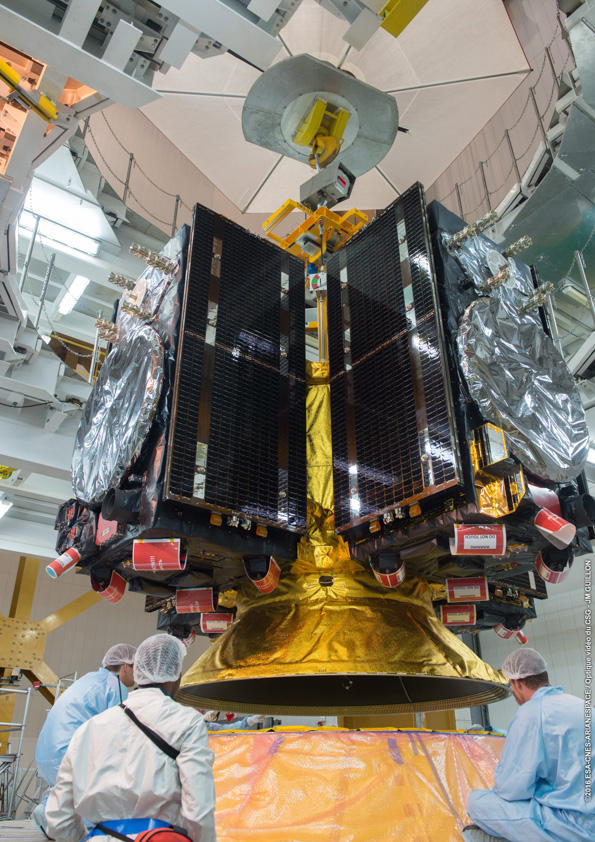
The Galileo satellites will ride aboard a specially-modified version of the Ariane 5 ES with a new dispenser developed by Airbus Defense and Space to accommodate four spacecraft bolted together.
The launcher version designed for Galileo missions also features a shortened nose cone enclosing the satellites, and a lightened Vehicle Equipment Bay structure compared to previous Ariane 5 ES flights, which carried heavy 20-ton Automated Transfer Vehicles on cargo runs to the International Space Station.
The Galileo satellites, manufactured in Germany by OHB System and outfitted with British-made navigation payloads from SSTL, are lighter and put less of a load on the Ariane 5’s structure.
Engineers also introduced electrical and thermal modifications to allow the Ariane 5’s upper stage to coast for more than three hours between engine burns, a requirement to inject the Galileo satellites close to their final operational orbits more than 14,000 miles (about 23,000 kilometers) above Earth.
The Ariane 5 ES configuration replaces the Ariane 5’s more commonly-used cryogenic upper stage, powered by a hydrogen-fueled HM7B engine, with an upper stage fitted with a hydrazine-burning Aestus engine. The key difference is the HM7B engine is only designed to fire one time in flight, while the Aestus is capable of multiple starts on the same mission.
Two upper stage burns are necessary for the Nov. 17 launch, but instead of coasting for less than an hour between firings as with previous flights of the Ariane 5 ES variant, the Aestus engine will switch off for more than three hours as the rocket climbs to the 14,000-mile-high altitude of the Galileo fleet for the final injection maneuver.
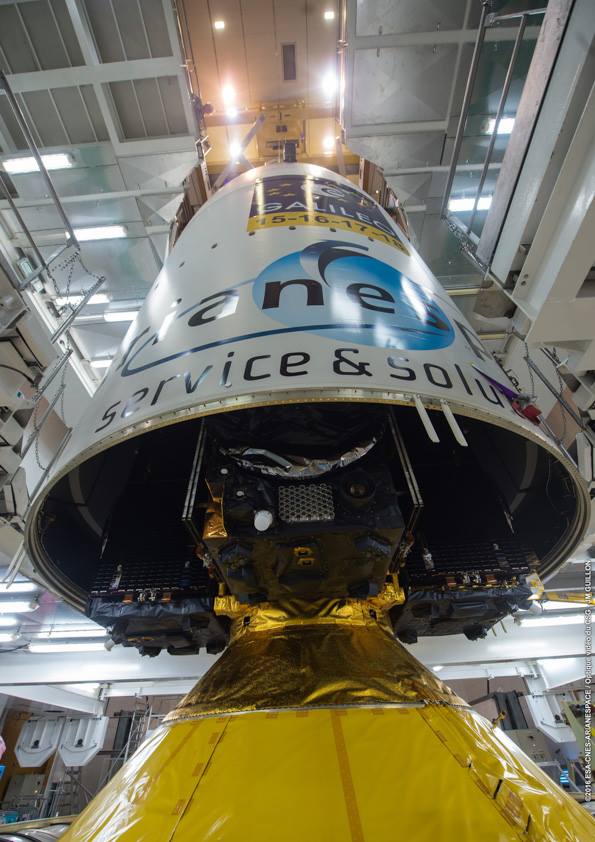
The critical upper stage burns will come after the Ariane 5’s main stage Vulcain 2 engine and twin solid rocket boosters propel the launcher off the pad in French Guiana. The 165-foot (50-meter) rocket will turn northeast from the Guiana Space Center, and let go of its two strap-on boosters at about T+plus 2 minutes, 19 seconds.
The Vulcain 2 engine, consuming a mix of liquid hydrogen and liquid oxygen, will fire for around nine minutes, then the upper stage’s Aestus powerplant will take over for the first of its two burns.
Separation of the first pair of Galileo satellites is expected at T+plus 3 hours, 35 minutes. The other two spacecraft will deploy from the rocket 20 minutes later.
Each Galileo satellite weighs about 1,580 pounds (717 kilograms) with a full load of fuel, according to a launch information kit released by Arianespace, the Ariane 5’s commercial operator.
Next week’s launch will mark the sixth Ariane 5 flight of the year, and the 89th overall. It will also be the ninth launch by Arianespace so far in 2016.
Technicians working inside the Guiana Space Center’s final assembly building topped off the 16-story rocket last week with the addition of the four satellites mounted on their dispenser Nov. 2. Workers lowered the rocket’s payload fairing, made in Switzerland by Ruag Space, over the satellites the next day.
The satellites set to go up Nov. 17 are nicknamed Antonianna, Lisa, Kimberley and Tijmen after the winners of a European children’s drawing contest.
Plans call for the Ariane 5 to roll out of the final assembly building for the 1.7-mile (2.7-kilometer) trip to the launch pad Nov. 15, with the final countdown commencing late Nov. 16.
More photos of the Galileo satellites, and their stacking atop the Ariane 5 rocket, are shown below.
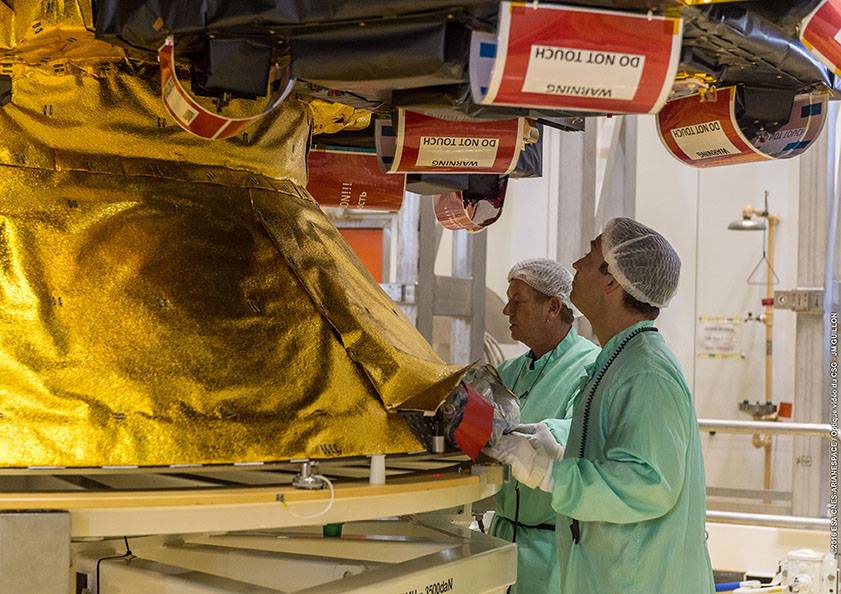
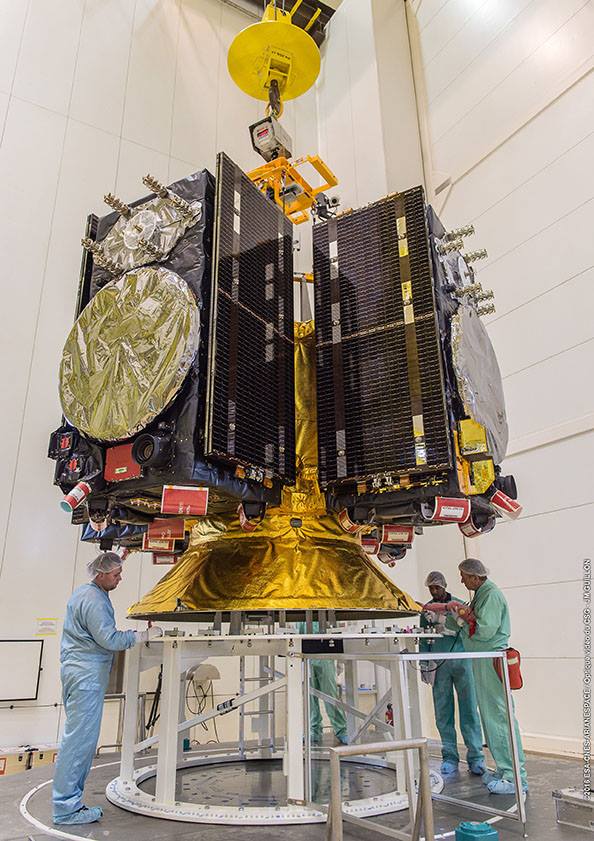
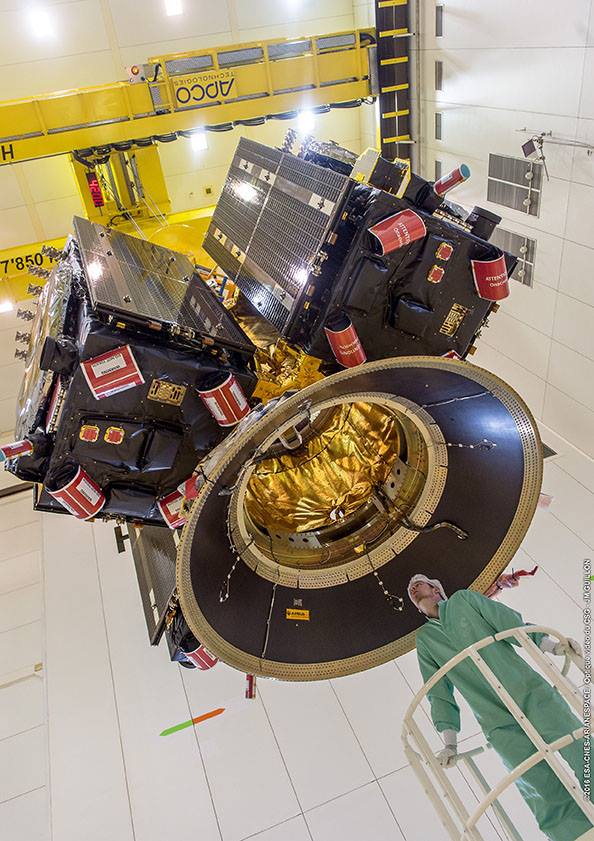
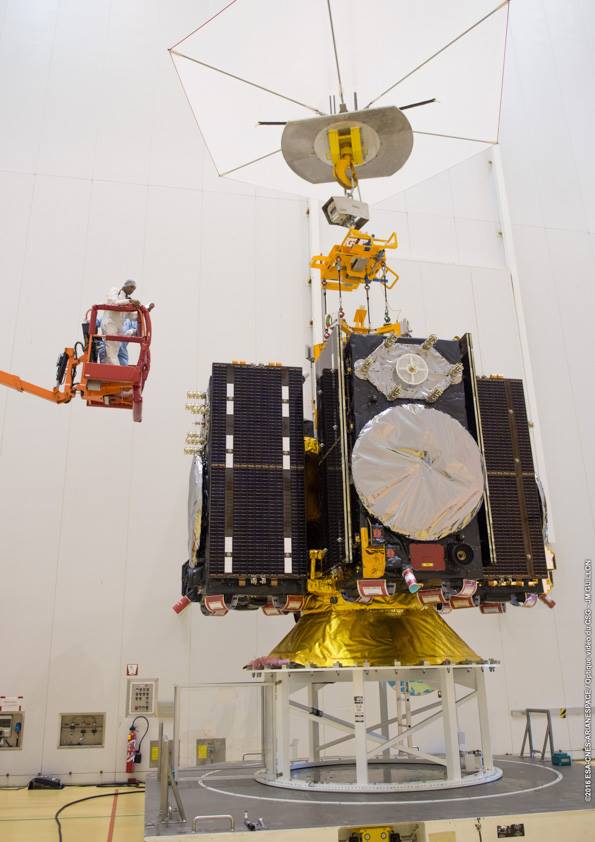

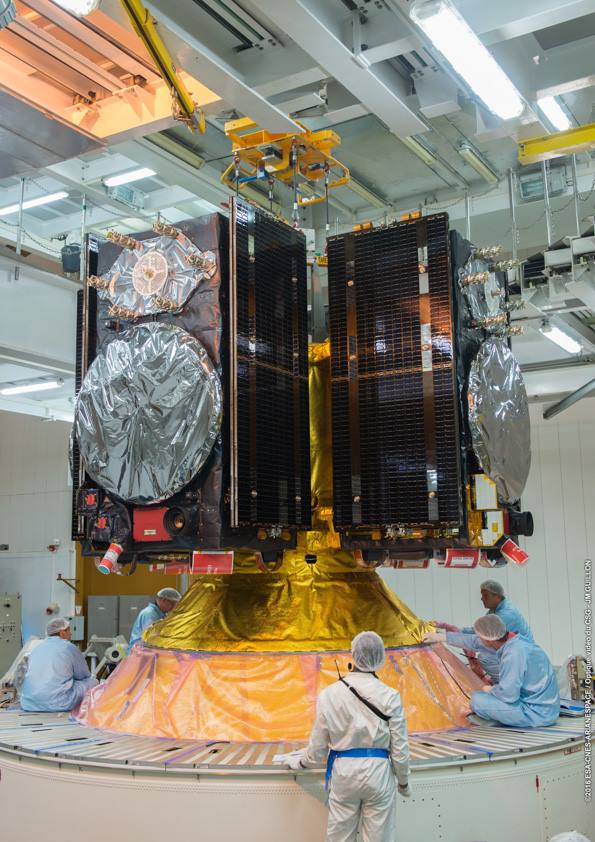

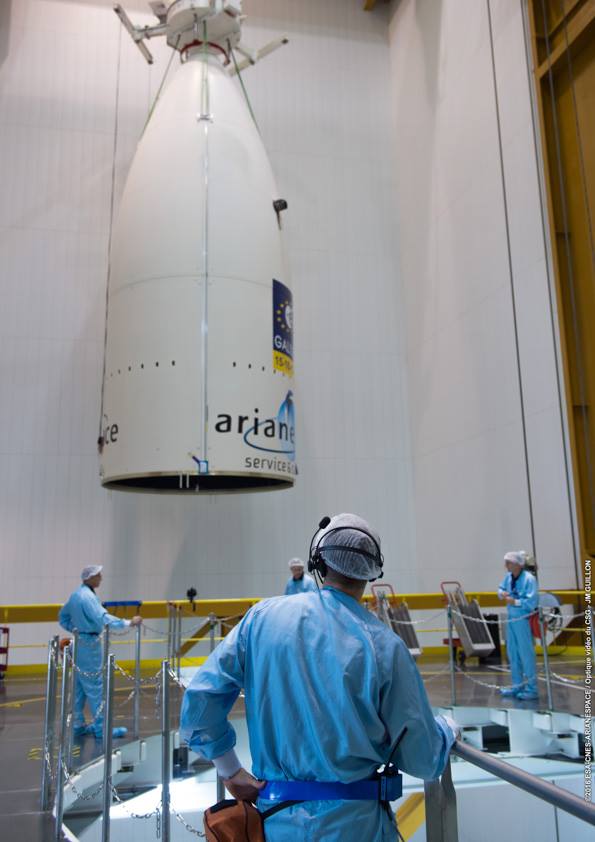
|
|||
| Quelle: arianespace |
-
Update: 17.11.2016
.
Arianespace’s first Ariane 5 mission with Galileo satellites is a “go” for launch
This week’s Arianespace flight with four European Galileo navigation system spacecraft has been approved for a morning liftoff on November 17 following the launch readiness review held today at the Spaceport in French Guiana.
Designated Flight VA233 in Arianespace’s numbering system – the launch will deploy its quartet of Galileo spacecraft during a nearly four-hour flight, with liftoff set at exactly 10:06:48 a.m. local time in French Guiana on Thursday.
Today’s launch readiness review validated the “go” status of the Ariane 5 ES launcher version, its Galileo passengers, as well as the Spaceport’s launch site infrastructure and the network of tracking stations.
The first Ariane 5 mission for Galileo
As a follow-up to Arianespace’s previous missions that used the medium-lift Soyuz to orbit Galileo satellites in pairs, the heavy-lift Ariane 5 enables four of the global positioning spacecraft to be accommodated on a single launch vehicle.
Arianespace previously deployed 14 Galileo in-orbit validation and full operational capability spacecraft from the Spaceport in French Guiana on seven Soyuz missions, along with performing two other Soyuz flights from the Baikonur Cosmodrome in Kazakhstan with the GIOVE-A and GIOVE-B experimental satellites for the Galileo system.
Galileo will offer a guaranteed, high-precision positioning service for Europe under civilian control. Its constellation will comprise 24 operational satellites, along with spares.
Satellites named after European children
The European Commission funds – and has overall responsibility – for Galileo’s management and implementation, with the European Space Agency assigned design and development of the new generation of systems and infrastructure.
OHB System in Bremen, Germany built the satellites to be orbited by Arianespace’s Flight VA233, and their navigation payloads were supplied by UK-based Surrey Satellite Technology Limited (SSTL), which is 99 percent owned by Airbus Defence and Space.
The four spacecraft carried by Ariane 5 are called Antonianna, Lisa, Kimberley and Tijmen – with their naming for winners of a European children’s drawing contest.
---
Ariane 5 arrives at the launch zone for Arianespace’s November 17 mission with four Galileo satellites
Arianespace’s sixth Ariane 5 for liftoff this year has rolled out to the launch zone in French Guiana, clearing the way for the heavy-lift vehicle’s first-ever mission to orbit satellites for Europe’s Galileo navigation system.

The Ariane 5 nears completion of its transfer from the Spaceport’s Final Assembly Building – where this heavy-lift vehicle received the payload of four Galileo satellites – to the ELA-3 launch zone.
The completed Ariane 5 was transferred today atop its mobile launch table from the Final Assembly Building – where payload integration occurred – to the Spaceport’s dedicated ELA-3 launch complex, setting the stage for Arianespace’s ninth overall mission in 2016 across its full family of Ariane 5, Soyuz and Vega vehicles.
Designated Flight VA233 in the company’s numbering system, this upcoming Ariane 5 mission – set for Thursday, November 17 – will lift off at exactly 10:06:48 a.m. local time in French Guiana and deploy its quartet of Galileo spacecraft during a nearly four-hour flight.
A heavy-lift launch for Europe
Galileo is an important infrastructure program for Europe, creating a civil global satellite navigation system that provides highly-accurate positioning with great precision and reliability.
It is funded by the European Union, with overall responsibility for management and implementation held by the European Commission – while design and development of the new generation of systems and infrastructure has been assigned to the European Space Agency.
In support of the Galileo program, Arianespace is using the Ariane 5 ES version with an enhanced storable propellant upper stage that allows for reignition and long coast phases during the mission.
These upgrades maximize the launcher’s performance for deploying the Galileo spacecraft – which will have a combined mass of 2,865 kg. at liftoff – two at a time into a circular medium-Earth orbit. The satellites were built by OHB System in Bremen, Germany, with UK-based Surrey Satellite Technology Limited (SSTL) supplying their navigation payloads.
... Update: 10.10 MEZ

...Update: 13.35 MEZ
Live-Frams von Ariane-V-VA-233 Start:

...13.50 MEZ



...


...14.07 MEZ










(Vogel-Durchflug)















Quelle: arianespace-tv
-
Update: 18.11.2016
LAUNCH OF NEW GALILEO NAVIGATION QUARTET
An Ariane 5 rocket has launched four additional Galileo satellites, accelerating deployment of the new satellite navigation system.
The Ariane 5, operated by Arianespace, lifted off from Europe’s Spaceport in Kourou, French Guiana at 13:06 GMT (14:06 CET, 10:06 local time) carrying Galileo satellites 15–18. The first pair was released 3 hours 35 minutes and 44 seconds after liftoff, while the second separated 20 minutes later.
The Galileos are at their target altitude, after a flawless release from the new dispenser designed to handle four satellites.
Over the next few days, engineers will nudge the satellites into their final working orbits and begin tests to ensure they are ready to join the constellation. This is expected to take six months or so.
This mission brings the Galileo system to 18 satellites.
The satellites already in orbit will allow the European Commission to declare the start of initial services, expected towards year’s end.
The previous 14 satellites were launched two at a time using the Soyuz–Fregat rocket.
“Now that we can rely on the powerful Ariane 5, we can anticipate the quicker completion of Galileo deployment, permitting the system to enter full operation,” remarked Paul Verhoef, ESA’s Director for the Galileo Programme and Navigation-related Activities.
Two additional Ariane 5 launches are scheduled in 2017 and 2018. The full system of 24 satellites plus spares is expected to be in place by 2020.
“With this 75th successful launch in a row, Ariane-5 sets a new record within European developed launchers and proves once more its reliability, " said Daniel Neuenschwander, ESA’s Director for Launchers.
About Galileo
Galileo is Europe’s civil global satellite navigation system. It will allow users worldwide to know their exact position in time and space with great precision and reliability. Once complete, the system will consist of 24 operational satellites and the ground infrastructure for the provision of positioning, navigation and timing services.
The Galileo programme is funded and owned by the EU. The European Commission has the overall responsibility for the programme, managing and overseeing the implementation of all programme activities.
Galileo’s deployment, the design and development of the new generation of systems and the technical development of infrastructure are entrusted to ESA. The definition, development and in-orbit validation phases were carried out by ESA, and co-funded by ESA and the European Commission.
The European Global Navigation Satellite System Agency (GSA) is ensuring the uptake and security of Galileo. Galileo operations and provision of services will be entrusted to the GSA from 2017.
Quelle: ESA
---
Arianespace doubles its Galileo delivery capacity with Ariane 5

Ariane 5’s trajectory is visible in this photo from the Spaceport’s Jupiter control center building.
Ariane 5’s first flight at the service of Galileo doubled Arianespace’s ability to orbit satellites for the European navigation system, while also marking the heavy-lift launcher’s 75 consecutive success.
With a precise on-time liftoff this morning from the Spaceport in French Guiana, the Ariane 5 ES launch vehicle delivered its quartet of passengers into medium-Earth circular orbit at the completion of a mission lasting 3 hours, 55 minutes.
They will join 14 Galileo in-orbit validation and full operational capability spacecraft previously launched in pairs by Arianespace on seven medium-lift Soyuz missions from French Guiana, along with two other Soyuz flights from Baikonur Cosmodrome in Kazakhstan with the system’s GIOVE-A and GIOVE-B experimental satellites.
More Ariane 5 launches for Galileo
The four spacecraft orbited today are called Antonianna, Lisa, Kimberley and Tijmen – named after children from Italy, Hungary, Malta and The Netherlands who won a European drawing contest.
Their deployment was performed by a new payload dispenser system from Airbus Safran Launchers, which also is prime contractor for Ariane 5.
Arianespace Chairman and CEO Stéphane Israël said two more Ariane 5s will continue the pace in 2017 and 2018, leading to 26 Galileo satellites in orbit.
Galileo brings civilian global positioning for Europe
As a high-precision positioning service, Galileo is designed to provide a new European global satellite navigation system under civilian control.

Flight VA233 lifted off at today’s precise scheduled moment of launch: 10:06:48 a.m. local time in French Guiana.
Funded by the European Union, overall responsibility for Galileo’s management and implementation is held by the European Commission, with the European Space Agency assigned design and development of the new generation of systems and infrastructure.
The four Galileo satellites on today’s Arianespace’s mission – designated Flight VA233 in the company’s launcher family numbering system – are sized at 2.7 x 1.2 x 1.1 meters and were built by OHB System in Bremen, Germany.
Their navigation payloads were supplied by UK-based Surrey Satellite Technology Limited (SSTL), which is 99-percent owned by Airbus Defence and Space.
Confirming Europe’s autonomous access to space
Speaking at the Spaceport after the four Galileo satellites’ deployment today, European Commissioner Elżbieta Bieńkowska underscored the role that Arianespace’s launcher family has in Europe’s space strategy, which includes the three Ariane 5s that have been acquired to support the satellite navigation system’s deployment.
“When the Commission decided to buy three Ariane 5 launchers…it was not only to accelerate our Galileo deployment, it also was an important element for our autonomous access to space,” said Bieńkowska, who is the European Commission’s Commissioner for Internal Market, Industry, Entrepreneurship and SMEs. “We will continue supporting the development of the most effective, reliable and competitive European launchers with the new Ariane 6 and Vega C.”
She added that Flight VA233 follows the recent adoption of a new European space strategy, which sets the priorities to be pursued during the next 10-15 years, adding this is the first time that Europe has such a roadmap.
75 successes in a row for Ariane 5
Flight VA233 also marked the 75th consecutive success for Ariane 5, further reinforcing its position as the launch services marketplace’s benchmark for reliability and performance.

With the new record for Arianespace’s full family of launchers, Ariane 5 has now surpassed its predecessor Ariane 4, Arianespace’s Israël added. “Let me congratulate all Ariane partners for this outstanding track record.”
Today’s mission was Arianespace’s ninth flight of 2016, continuing the momentum that has seen all three members of its launcher family in action this year. The other launches performed since January utilized five heavy-lift Ariane 5s, two medium-lift Soyuz vehicles and one lightweight Vega.
The next Arianespace mission is being readied for liftoff on December 5, using a Vega to orbit the GÖKTÜRK-1A Earth observation satellite for Turkey.

Quelle: arianespace
-
Twin success for Ariane 5 and European space industry: first Ariane 5 for the Galileo constellation and 75th successful launch in a row for this launcher!

Arianespace has successfully launched satellites 15, 16, 17 and 18 in the Galileo satellite navigation system for the European Commission (DG Growth), within the scope of a contract with the European Space Agency (ESA).
 The Ariane 5 launch took place on November 17 at 10:06 a.m. (local time) from the Guiana Space Center in Kourou, French Guiana. Maroš Šefčovič, Vice President of the European Commission, and Elżbieta Bieńkowska, European Commissioner for Internal Market, Industry, Entrepreneurship and SMEs, were on hand for the launch.
The Ariane 5 launch took place on November 17 at 10:06 a.m. (local time) from the Guiana Space Center in Kourou, French Guiana. Maroš Šefčovič, Vice President of the European Commission, and Elżbieta Bieńkowska, European Commissioner for Internal Market, Industry, Entrepreneurship and SMEs, were on hand for the launch.
Today’s launch was the eighth from the Guiana Space Center for Galileo and the first using an Ariane 5 launcher (ES version). Arianespace has now orbited 18 Galileo satellites, more than two-thirds of those that will eventually be deployed by the constellation, enabling Europe’s satellite navigation system to start services as early as the end of this year.
The launch was the ninth of the year for Arianespace and the sixth with Ariane 5, marking the 75th successful launch in a row for this heavy-lift launcher and surpassing the previous record set by Ariane 4. With today’s successful and doubly symbolic mission, Arianespace is proud to support Europe’s ambitious space objectives while also continuing to demonstrate its unrivaled reliability that is unparalleled in the market.
Ariane 5 sets an all-time record for successful launches in a row
Today’s mission marks the 75th successful launch in a row for Ariane 5, an all-time record for the Arianespace launcher family in French Guiana. Ariane 5 has performed 75 launches from 2003 to 2016, orbiting 149 payloads with a cumulative weight of more than 623 metric tons (about 1.4 million pounds), for both government and commercial customers.
This string of successes is further proof of the exceptional reliability and availability offered by Arianespace’s heavy launcher, while confirming its position as the most reliable launcher in the commercial market.
| Galileo launches by the Arianespace family:
|
First Ariane 5 launch for Galileo
Today’s launch is the first Ariane 5 (ES version) mission for the Galileo program.
By successfully orbiting four more satellites for the Galileo constellation, Ariane 5 has demonstrated its flexibility and adaptability: the restartable EPS upper stage, and the new dispenser specially developed by Airbus Safran Launchers to hold the four satellites under the launcher’s fairing and release them in pairs, both operating flawlessly.
Arianespace will subsequently deploy the next eight satellites in the constellation, now under construction by OHB in Bremen, Germany, with two more Ariane 5 launches in the second half of 2017 and in early 2018.
|
Europe initiated the Galileo program to develop a new global navigation satellite system. Under civilian control, it will offer a guaranteed, high-precision positioning service. The Galileo system is designed to provide a European solution as an alternative to the American GPS (Global Positioning System). It will be based on a fleet of 24 operational satellites (along with replacement satellites), 18 of which have already been orbited by Arianespace. Galileo features innovative technologies developed in Europe to benefit all citizens. It is funded by the European Union. |
Guaranteeing independent access to space for Europe
Following successful Soyuz launches in 2016 for the Copernicus program (VS14) and Galileo (VS15), today’s launch was the third of the year by Arianespace for the European Commission and ESA. These two European institutions recently strongly reaffirmed their commitment to European launchers:
- On October 26, the European Union unveiled its long-term space strategy with a strong reference to the upcoming Ariane 6 and Vega C launchers, as well as the associated launch infrastructures.
- On November 9, ESA and Airbus Safran Launchers signed an agreement confirming the Ariane 6 program. The first flight of this new launcher is slated for 2020, paving the way for Arianespace to start marketing launches as early as the end of this year.
With nine more satellite launches in the order book managed within the scope of contracts conducted by ESA (one Sentinel-2B mission and two Galileo missions), the European Commission retains its position as Arianespace’s leading government customer.
 Shortly after the announcement of the orbital injection of the four satellites, Stéphane Israël, Chairman and CEO of Arianespace, said: “Congratulations Europe! Four more Galileo satellites are now in orbit with our eighth launch for the constellation, also the third of the year for the European Commission and ESA. Arianespace is proud to guarantee independent access to space for Europe. Providing a highly complementary fit with Soyuz launcher from CSG, the Ariane 5 ES launcher is taking over responsibility for the deployment of Galileo, marking another step towards European independence in satellite navigation. I would like to thank the European Union, especially the European Commission’s DG Growth, as well as the European Space Agency, our direct customer for this launch, for continuing to entrust us with their satellites. Coming shortly after the publication of the European Union’s space strategy, we were very honored to welcome Vice President Šefčovič and Commissioner Bieńkowska to witness this launch.
Shortly after the announcement of the orbital injection of the four satellites, Stéphane Israël, Chairman and CEO of Arianespace, said: “Congratulations Europe! Four more Galileo satellites are now in orbit with our eighth launch for the constellation, also the third of the year for the European Commission and ESA. Arianespace is proud to guarantee independent access to space for Europe. Providing a highly complementary fit with Soyuz launcher from CSG, the Ariane 5 ES launcher is taking over responsibility for the deployment of Galileo, marking another step towards European independence in satellite navigation. I would like to thank the European Union, especially the European Commission’s DG Growth, as well as the European Space Agency, our direct customer for this launch, for continuing to entrust us with their satellites. Coming shortly after the publication of the European Union’s space strategy, we were very honored to welcome Vice President Šefčovič and Commissioner Bieńkowska to witness this launch.
“Arianespace today is celebrating the 75th successful Ariane 5 launch in a row, an all-time record for our launcher family in French Guiana. I would like to thank all of our partners who contributed to this historic achievement: the European Space Agency and member-States in the Ariane program; Airbus Safran Launchers, our industrial prime contractor and largest shareholder; and all companies contributing to the production of Ariane; CNES/CSG, our ground segment companies and all staff at the space center. And of course congratulations to everybody at Arianespace for this ninth successful launch of the year.”
| Following today’s mission, the 54th for ESA, Arianespace will orbit three additional satellites:
|
|
Galileo FOC-M6 satellites 15, 16, 17 and 18 The 15th to 18th satellites were built by prime contractor OHB System in Bremen, Germany, with the payloads supplied by UK-based SSTL (Surrey Satellite Technology Ltd., 99 percent owned by Airbus Defence and Space). The satellites weighed 714, 715, 714 and 715 kg. at launch, respectively, and were placed in a circular medium Earth orbit (MEO) in Plane C, at an altitude of 22,922 km. and an inclination of 54.57 degrees. They will subsequently be moved to their operational orbit at an altitude of 23,222 km. |
About Arianespace
Arianespace uses space to make life better on Earth by providing launch services for all types of satellites into all orbits. It has orbited more than 540 satellites since 1980, using its family of three launchers, Ariane, Soyuz and Vega, from launch sites in French Guiana (South America) and Baikonur, Kazakhstan. Arianespace is headquartered in Evry, near Paris, and has a technical facility at the Guiana Space Center, Europe’s Spaceport in French Guiana, plus local offices in Washington, D.C., Tokyo and Singapore.
Quelle: arianespace





